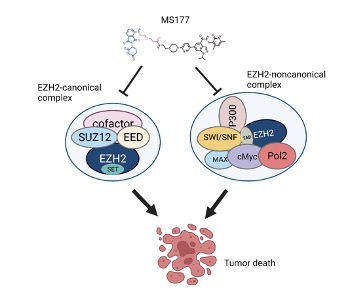
Researchers at the University of North Carolina at Chapel Hill and the UNC Lineberger Comprehensive Cancer Center have uncovered a new role of a chromatin-modulatory enzyme, termed EZH2, during cancer development. They then developed a new therapeutic approach with a potent small-molecule inhibitor of this enzyme.
Certain subtypes of blood cancers such as acute leukemias rely on multiple mechanisms for sustaining growth of aggressive cancer cells. Notably, these mechanisms include those driven by EZH2, a chromatin-modulatory enzyme, and cMyc, a prominent cancer-causing factor. UNC researchers now show that these two factors can directly associate with one another, modulating cancer-cell-specific programs of gene expression.
To develop pharmacological means of targeting both EZH2 and cMyc, they teamed with the chemical biologists at Icahn School of Medicine at Mount Sinai and designed a new small-molecule, MS177, based on the proteolysis-targeting chimera (PROTAC) technology. MS177 targets both EZH2 and cMyc and thus inhibit cancer growth.
Their findings were published online Feb. 24, 2022, in Nature Cell Biology.
“EZH2 plays a very important role during cancer progression and is a known target suitable for drug development,” said UNC Lineberger’s Greg Wang, PhD, associate professor of Biochemistry and Biophysics and Pharmacology at the UNC School of Medicine and co-lead author of this research article. “We are amazed by the efficiency of small-molecule PROTAC in simultaneously targeting EZH2 and cMyc in cancer cells.”

They found that EZH2 possesses two different binding patterns on chromatin in acute leukemia cells, eliciting two distinct gene-regulatory programs (Figure 1). On the one hand, EZH2 forms a canonical protein complex termed PRC2, leading to gene repression at a set of genomic regions; on the other hand, EZH2 interacts with cMyc to activate gene expression at genomic sites distinctive from the above ones. “This explains why the current small-molecule inhibitors of EZH2 cannot block EZH2 completely. PROTAC addresses this gap,” said Jun Wang, PhD, postdoctoral researcher at UNC Lineberger and co-first author of the work.
MS177 achieves on-target effect in cancer cells and exhibits profound tumor killing effects, the researchers report. “Compared to the existing enzymatic inhibitors, MS177 is more likely to behave much better for the treatment of patients with acute leukemias. To our knowledge, an agent for dual targeting of EZH2 and cMyc has not been developed before. cMyc is hard to ‘drug,’” Greg Wang said. “MS177 thus represents a promising candidate for treating other cancers depending on the above tumorigenic pathways.”
Authors and disclosures
In addition to Greg Wang, Jin and Jun Wang, the paper’s other authors are Weida Gong, PhD, Xijuan Liu, PhD, Yi-Hsuan Tsai, PhD, David F. Allison, PhD, Ling Cai, PhD, UNC; Xufen Yu, PhD, Kwang-Su Park, PhD, Anqi Ma, PhD, Yudao Shen, PhD, and Jing Liu, PhD, Icahn School of Medicine at Mount Sinai, New York; Takashi Onikubo, PhD, and Robert G. Roeder, PhD, Rockefeller University, New York; Wen-Chieh Pi, PhD, and Wei-Yi Chen, PhD, National Yang Ming Chiao Tung University, Taipei, Taiwan.
This work was supported in part by grants from the National Institutes of Health, R01CA218600, R01CA268519, R01CA211336, R01CA215284, R01CA230854, and R01GM122749; Kimmel Scholar Award; Gabrielle’s Angel Foundation for Cancer Research; When Everyone Survives Leukemia Research Foundation; and the University Cancer Research Fund. Wang is an American Cancer Society Research Scholar, a Leukemia and Lymphoma Society Scholar, and an American Society of Hematology Scholar in Basic Science.
Yu, Ma, Shen, Lui, and Jin are inventors of patent applications filed by the Icahn School of Medicine at Mount Sinai. The Jin Laboratory received research funds from Celgene Corporation, Levo Therapeutics, Cullgen, Inc., and Cullinan Oncology. Jin is a co-founder, scientific advisory board member and equity shareholder in Cullgen Inc., and is a consultant for Cullgen Inc., EpiCypher Inc. and Accent Therapeutics Inc. The remaining authors declare no competing interests.
